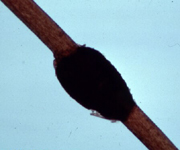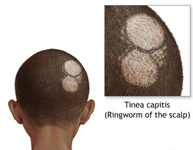Mycosis – What Diseases Molds Can Cause?
There are four categories of fungal infections (mycosis), i.e. superficial mycosis (without tissue response), Mucocutaneous mycosis (skin, eyes, sinuses, oropharynx, external ears, and vagina), subcutaneous mycosis, and Deep organ mycosis.
Recently, there is an increase of opportunistic, systemic mycosis in immunocompromised patients. The patients may have been impaired as a result of the development of neoplasia, leukemia, metabolic diseases (diabetes mellitus), drug therapy (cytostatics, antibiotics, and corticosteroids), intravenous drug abuse or infections (AIDS).

What Diseases Molds Can Cause?
Piedra mold on a hair shaft (Ref: doctorfungus.org)
Superficial Mycosis (human or animal body, skin surface, such as hair or lipids, without provoking any immune response).
1. Piedra, this is infection of the hair shaft. Black Piedra is caused by mold Piedraia hortae; white piedra, caused by mold Trichosporon species.
2. Tinea nigra, brown or black, superficial skin lesions, mostly on hands and soles, of mostly young girls, caused by mold Hortaea werneckii.
3. Pityriasis versicolor, yeasts Malassezia causes skin infection in lipid excretions, leading to seborrhoeic dermatitis.
4. Otitis externa, external ear infected by Aspergillus, Malassezia sp. or Pseudallescheria boydii.
5. Superficial dermatophytoses (hair, nail and skin infection), caused by keratinophilic dermatophytous molds Arthroconidia and Trichophyton.

ringworm of the scalp
Ringworm of Scalp (Ref: NIH, Medical Encyclopedia)
Cutaneous Mycosis (on outermost skin layers such as epidermis, Mucocutaneous membranes, genitalia or external ears)
1. Ringworm, is not caused by worms, but instead molds, so called Tinea of various types. The symptoms are circular skin lesions with slightly raised, red margins, containing numerous scales and surrounded by reddish, itching skin. Causative molds are Mycosporium, Trichophyton and Epidermaphyton.
2. Favus, A bald spot on the haired skin caused by mold infection Trichophyton schoenleinii.
3. Onychomycosis. Chronic nail infection esp. toenails, by mold Trichophyton, Scopulariopsis and yeast Candida.
4. Hyperkeratosis. Extended hand and foot scaling caused by mold Nattrassia mangiferae.
5. Intertrigo, Yeast Candida infection of humid folds of the skin.
6. Mucocutaneous candidiasis, such as Thrush and Vulvo-vaginitis, caused by Candida species, mostly C. albicans. The yeast Candida albicans is an extremely common colonizer of mucous membranes.
7. Keratitis, mold infection of eye due to surgery, use of corticosteroids, or careless application of contact lenses, caused mostly Aspergillus and Fusarium and other saprobic molds.
8. Chromoblastomycosis occurs mostly on the extremities with localized, slowly expanding lesions. Superficial, warty to cauliflower-like tumors and deformations develop, causing molds: Fonsecaea, Cladophialophora, Phialophora, and Rhinocladiella.

Eye Keratitis
Eye keratitis (Ref: cehjournal.org)
Subcutaneous Mycosis (Local, chronic, traumatic infection of the subcutis, maybe disfiguring decades-long but non- life-threatening, provoking immune response and leading to cysts or granuloma).
1. Non-ulcerative infections by diverse fungi, forming cysts locally in skin;
2. Eumycetoma, in which necrotic, pus-oozing lesion cavities are formed in tissue, causants are molds Acremonium, Neotestudina, Pseudallescheria, Madurella, Leptosphaeria Pyrenochaeta and black yeast Exophiala.
3. Sporotrichosis, skin infection caused by dimorphic mold Sporothrix schenckii;
4. Primary subcutaneous Blastomycosis, a rare chronic, granulomatous inflammation of the skin with ulceration, caused by dangerous mold Blastomyces dermatitidis.
5. Subcutaneous conidiobolomycosis mostly infect skin of legs, arms and buttocks, caused by molds Conidiobolus and Basidiobolus.
6. Zygomycotic rhinitis, the mucosa infected by molds Zygomycotic leading to meningitis. Most common agents are mold Rhizopus species.
7. Mycotic sinusitis, acute infection of the nasal mucosa with allergic reactions to local colonization, caused by, mostly Mucorales or Aspergillus, as well as nonpathogenic molds Curvularia, Bipolaris and Exserohilum. In immunocompromised patients this may be fatal.

Blastomycosis
Blastomycosis (Ref: mycology.adelaide.edu.au)
Deep Organ Mycosis (Deep mycosis in immunosuppressed patients are acquired either by inhalation, wounds, catheter-related infection or needles. The mycosis includes Systemic Mycosis or Disseminated Mycosis or Secondary Cutaneous Mycosis, mostly in immune-compromised population).
1. Blastomycosis, a granulomatous disease, caused by Blastomyces dermatitidis through pulmonary infection If untreated, the disease is usually fatal.
2. Paracoccidioidomycosis, caused by Paracoccidioides brasiliensis, through lungs with the fungus disseminating to the mucosal areas. When untreated, the disease is nearly always fatal.
3. Coccidioidomycosis is through inhalation of airborne spores of Coccidioides immitis, leading to non-specific fever with bronchopneumonia, mostly the disease resolves spontaneously. Dissemination of this disease to the whole body is often fatal.
4. Histoplasmosis caused by mold Histoplasma capsulatum infecting monocytes or macrophages. The disseminated form is frequently fatal.
5. Penicilliosis, caused by Penicillium marneffei through inhalation, which is endemic in Southeast Asia. With impairment of the immune system, such as AIDS, the mold multiplies in the monocyte-macrophage system. Fatal if untreated.
6. Aspergillosis, including Aspergilloma, and Aspergillosis of many types, mostly caused byAspergillus flavus or A. fumigatus. In the case of Invasive aspergillosis, if untreated, the mortality rate is high. Aspergillus fumigatus infection comprises about 90% of clinical cases of deep organ/tissue mycotic infections.
7. Cryptococcosis, invades tissues by yeast Cryptococcus neoformans when immunity weakens, often l leads to meningitis.
8. Candidiasis, caused by Candida albicans, or lesser by C. tropicalis and C. glabrata. The species is commonly present in human mucosa, which becomes invasive when immunity weakens. In newborns natural resistance is low; candidiasis can develop within a few days. Disseminated Candidiasis can be fatal when untreated.
9. Zygomycosis caused by molds of Mucorales, Sep. Rhizopus species. The fungi show invasive growth, preferentially in the walls and Lumina of blood vessel.
10. Coccidiodomycosis. In Southwest USA, this mycosis is endemic with high occurrence, stretching from New Mexico, Arizona to Texas (Photo ref: mycology.adelaide.edu.au).
